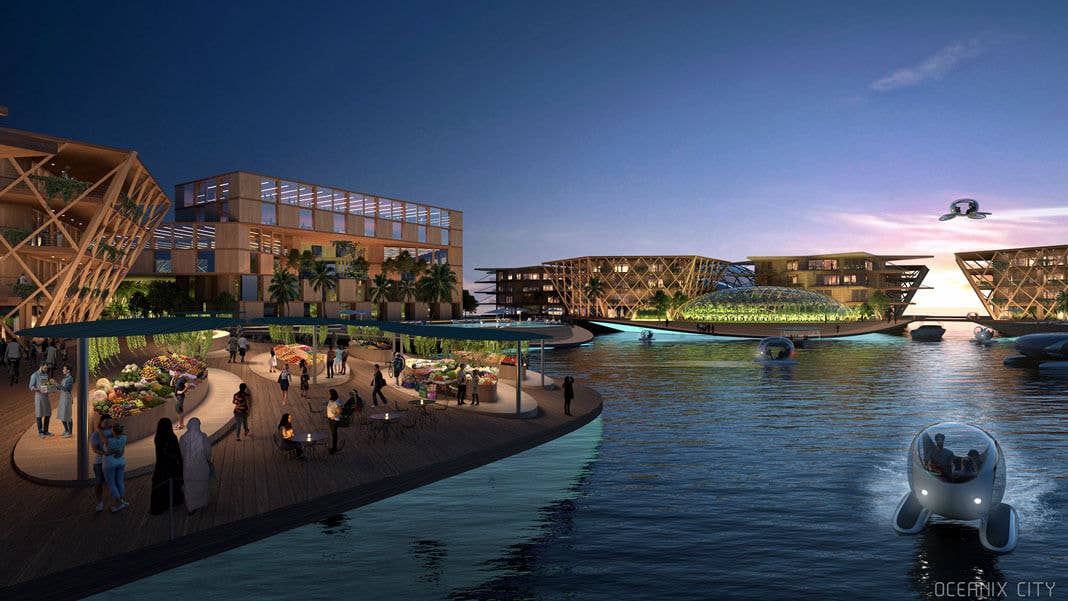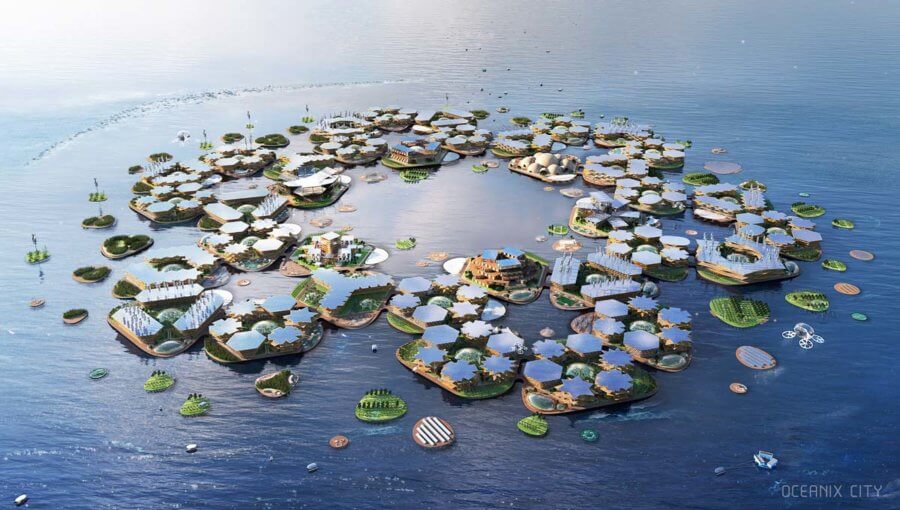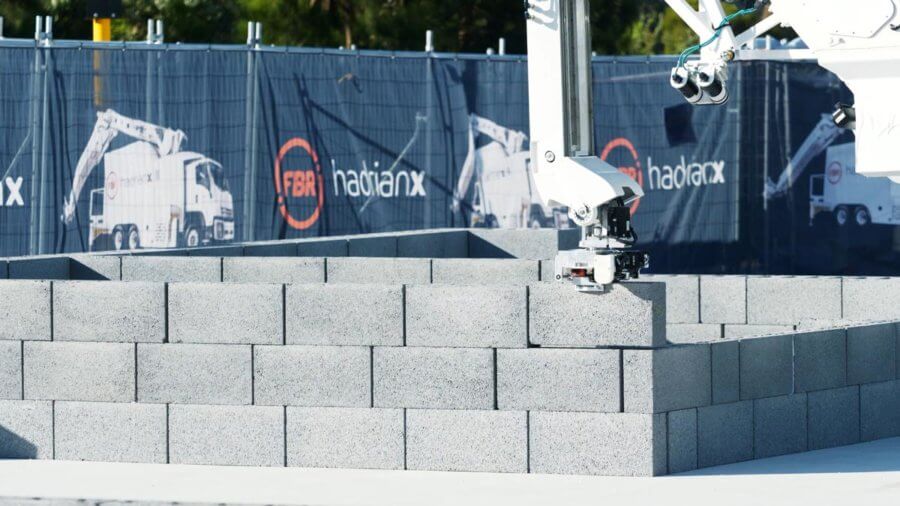The Futuristic Tech Disrupting Real Estate and Construction

Share
In the wake of the housing market collapse of 2008, one entrepreneur decided to dive right into the failing real estate industry. But this time, he didn’t buy any real estate to begin with. Instead, Glenn Sanford decided to launch the first-ever cloud-based real estate brokerage, eXp Realty.
Contracting virtual platform VirBELA to build out the company’s mega-campus in VR, eXp Realty demonstrates the power of a dematerialized workspace, throwing out hefty overhead costs and fundamentally redefining what ‘real estate’ really means. Ten years later, eXp Realty has an army of 14,000 agents across all 50 US states, 3 Canadian provinces, and 400 MLS market areas… all without a single physical office.
But VR is just one of many exponential technologies converging to revolutionize real estate and construction. As floating cities and driverless cars spread out your living options, AI and VR are together cutting out the middleman.
Already, the global construction industry is projected to surpass $12.9 trillion in 2022, and the total value of the US housing market alone grew to $33.3 trillion last year. Both vital for our daily lives, these industries will continue to explode in value, posing countless possibilities for disruption.
In this blog, I’ll be discussing the following trends:
- New prime real estate locations;
- Disintermediation of the real estate broker and search;
- Materials science and 3D printing in construction.
Let’s dive in!
Location Location Location
Until today, location has been the name of the game when it comes to hunting down the best real estate. But constraints on land often drive up costs while limiting options, and urbanization is only exacerbating the problem.
Beyond the world of virtual real estate, two primary mechanisms are driving the creation of new locations.
(1) Floating Cities
Offshore habitation hubs, floating cities have long been conceived as a solution to rising sea levels, skyrocketing urban populations, and threatened ecosystems. In success, they will soon unlock an abundance of prime real estate, whether for scenic living, commerce, education, or recreation.
One pioneering model is that of Oceanix City, designed by Oceanix (led by CEO and founder Marc Collins Chen), BIG-Bjarke Ingels Group, and a host of other domain experts. Intended to adapt organically over time, Oceanix would consist of a galaxy of mass-produced, hexagonal floating modules, built as satellite “cities” off coastal urban centers and sustained by renewable energies.
While individual 4.5-acre platforms would each sustain 300 people, these hexagonal modules are designed to link into 75-acre tessellations sustaining up to 10,000 residents. Each anchored to the ocean floor using biorock, Oceanix cities are slated to be closed-loop systems, as external resources are continuously supplied by automated drone networks.
Electric boats or flying cars might zoom you to work, city-embedded water capture technologies would provide your water, and while vertical and outdoor farming supply your family meal, share economies would dominate goods provision.

AERIAL: Located in calm, sheltered waters, near coastal megacities, OCEANIX City will be an adaptable, sustainable, scalable, and affordable solution for human life on the ocean. Image Credit: OCEANIX/BIG-Bjarke Ingels Group.
Joined by countless government officials whose islands risk submersion at the hands of sea level rise, the UN is now getting on board. And just this year, seasteading is exiting the realm of science fiction and testing practical waters.
As French Polynesia seeks out robust solutions to sea level rise, their government has now joined forces with the San Francisco-based Seasteading Institute. With a newly designated special economic zone and 100 acres of beachfront, this joint Floating Island Project could even see up to a dozen inhabitable structures by 2020. And what better to fund the $60 million project than the team’s upcoming ICO?
But aside from creating new locations, autonomous vehicles (AVs) and flying cars are turning previously low-demand land into the prime real estate of tomorrow.
(2) Autonomous Electric Vehicles and Flying Cars
Today, the value of a location is a function of its proximity to your workplace, your city’s central business district, the best schools, or your closest friends.
But what happens when driverless cars desensitize you to distance, or Hyperloop and flying cars decimate your commute time? Historically, every time new transit methods have hit the mainstream, tolerance for distance has opened up right alongside them, further catalyzing city spread.
And just as Hyperloop and the Boring Company aim to make your commute immaterial, autonomous vehicle (AV) ridesharing services will spread out cities in two ways: (1) by drastically reducing parking spaces needed (vertical parking decks = more prime real estate); and (2) by untethering you from the steering wheel. Want an extra two hours of sleep on the way to work? Schedule a sleeper AV and nap on your route to the office. Need a car-turned-mobile-office? No problem.
Meanwhile, aerial taxis (i.e. flying cars) will allow you to escape ground congestion entirely, delivering you from bedroom to boardroom at decimated time scales.
Already working with regulators, Uber Elevate has staked ambitious plans for its UberAIR airborne taxi project. By 2023, Uber anticipates rolling out flying drones in its two first pilot cities, Los Angeles and Dallas. Flying between rooftop skyports, drones would carry passengers at a height of 1,000 to 2,000 feet at speeds between 100 to 200 mph. And while costs per ride are anticipated to resemble those of an Uber Black based on mileage, prices are projected to soon drop to those of an UberX.
But the true economic feat boils down to this: if I were to commute 50 to 100 kilometers, I could get two or three times the house for the same price. (Not to mention the extra living space offered up by my now-unneeded garage.)
All of a sudden, virtual reality, broadband, AVs, or high-speed vehicles are going to change where we live and where we work. So rather than living in a crowded, dense urban core for access to jobs and entertainment, our future of personalized, autonomous, low-cost transport opens the luxury of rural areas to all without compromising the benefits of a short commute.
Once these drivers multiply your real estate options, how will you select your next home?
Disintermediation: Say Bye to Your Broker
In a future of continuous and personalized preference-tracking, why hire a human agent who knows less about your needs and desires than a personal AI?
Just as disintermediation is cutting out bankers and insurance agents, so too is it closing in on real estate brokers. Over the next decade, as AI becomes your agent, VR will serve as your medium.
To paint a more vivid picture of how this will look, over 98 percent of your home search will be conducted from the comfort of your couch through next-generation VR headgear.
Once you’ve verbalized your primary desires for home location, finishings, size, etc. to your personal AI, it will offer you top picks, tour-able 24/7, with optional assistance by a virtual guide and constantly updated data. As a seller, this means potential buyers from two miles, or two continents, away.
Throughout each immersive VR tour, advanced eye-tracking software and a permissioned machine learning algorithm follow your gaze, further learn your likes and dislikes, and intelligently recommend other homes or commercial residences to visit.
Curious as to what the living room might look like with a fresh coat of blue paint and a white carpet? No problem! VR programs will be able to modify rendered environments instantly, changing countless variables, from furniture materials to even the sun’s orientation. Keen to input your own furniture into a VR-rendered home? Advanced AIs could one day compile all your existing furniture, electronics, clothing, decorations, and even books, virtually organizing them across any accommodating new space.
As 3D scanning technologies make extraordinary headway, VR renditions will only grow cheaper and higher resolution. One company called Immersive Media (disclosure: I’m an investor and advisor) has a platform for 360-degree video capture and distribution, and is already exploring real estate 360-degree video.
Smaller firms like Studio 216, Vieweet, Arch Virtual, ArX Solutions, and Rubicon Media can similarly capture and render models of various properties for clients and investors to view and explore. In essence, VR real estate platforms will allow you to explore any home for sale, do the remodel, and determine if it truly is the house of your dreams.
Once you’re ready to make a bid, your AI will even help estimate a bid, process and submit your offer. Real estate companies like Zillow, Trulia, Move, Redfin, ZipRealty (acquired by Realogy in 2014) and many others have already invested millions in machine learning applications to make search, valuation, consulting, and property management easier, faster, and much more accurate.
But what happens if the home you desire most means starting from scratch with new construction?
New Methods and Materials for Construction
For thousands of years, we’ve been constrained by the construction materials of nature. We built bricks from naturally abundant clay and shale, used tree limbs as our rooftops and beams, and mastered incredible structures in ancient Rome with the use of cement.
But construction is now on the cusp of a materials science revolution. Today, I’d like to focus on three key materials:
- Upcycled Materials
Be Part of the Future
Sign up to receive top stories about groundbreaking technologies and visionary thinkers from SingularityHub.


Imagine if you could turn the world’s greatest waste products into their most essential building blocks. Thanks to UCLA researchers at CO2NCRETE, we can already do this with carbon emissions.
Today, concrete produces about five percent of all greenhouse gas (GHG) emissions. But what if concrete could instead conserve greenhouse emissions? CO2NCRETE engineers capture carbon from smokestacks and combine it with lime to create a new type of cement. The lab’s 3D printers then shape the upcycled concrete to build entirely new structures. Once conquered at scale, upcycled concrete will turn a former polluter into a future conserver.
Or what if we wanted to print new residences from local soil at hand? Marking an extraordinary convergence between robotics and 3D printing, the Institute of Advanced Architecture of Catalonia (IAAC) is already working on a solution.
In a major feat for low-cost construction in remote zones, IAAC has found a way to convert almost any soil into a building material with three times the tensile strength of industrial clay. Offering myriad benefits, including natural insulation, low GHG emissions, fire protection, air circulation, and thermal mediation, IAAC’s new 3D printed native soil can build houses on-site for as little as $1,000.
- Nanomaterials
Nano- and micro-materials are ushering in a new era of smart, super-strong, and self-charging buildings. While carbon nanotubes dramatically increase the strength-to-weight ratio of skyscrapers, revolutionizing their structural flexibility, nanomaterials don’t stop here.
Several research teams are pioneering silicon nanoparticles to capture everyday light flowing through our windows. Little solar cells at the edges of windows then harvest this energy for ready use. Researchers at the US National Renewable Energy Lab have developed similar smart windows. Turning into solar panels when bathed in sunlight, these thermochromic windows will power our buildings, changing color as they do.
- Self-Healing Infrastructure
The American Society of Civil Engineers estimates that the US needs to spend roughly $4.5 trillion to fix nationwide roads, bridges, dams, and common infrastructure by 2025. But what if infrastructure could fix itself?
Enter self-healing concrete. Engineers at Delft University have developed bio-concrete that can repair its own cracks. As head researcher Henk Jonkers explains, “What makes this limestone-producing bacteria so special is that they are able to survive in concrete for more than 200 years and come into play when the concrete is damaged. […] If cracks appear as a result of pressure on the concrete, the concrete will heal these cracks itself.”
But bio-concrete is only the beginning of self-healing technologies. As futurist architecture firms start printing plastic and carbon-fiber houses like the stunner seen below (using Branch Technologies’ 3D printing technology), engineers have begun tackling self-healing plastic.
And in a bid to go smart, burgeoning construction projects have started embedding sensors for preemptive detection. Beyond materials and sensors, however, construction methods are fast colliding into robotics and 3D printing.
While some startups and research institutes have leveraged robot swarm construction (namely, Harvard’s robotic termite-like swarm of programmed constructors), others have taken to large-scale autonomous robots.
One such example involves Fastbrick Robotics. After multiple iterations, the company’s Hadrian X end-to-end bricklaying robot can now autonomously build a fully livable, 180-square meter home in under 3 days. Using a laser-guided robotic attachment, the all-in-one brick-loaded truck simply drives to a construction site and directs blocks through its robotic arm in accordance with a 3D model.

Layhead. Image Credit: Fastbrick Robotics.
Meeting verified building standards, Hadrian and similar solutions hold massive promise in the long term, deployable across post-conflict refugee sites and regions recovering from natural catastrophes.
Imagine the implications. Eliminating human safety concerns and unlocking any environment, autonomous builder robots could collaboratively build massive structures in space or deep underwater habitats.
Final Thoughts
Where, how, and what we live in form a vital pillar of our everyday lives. The concept of “home” is unlikely to disappear anytime soon. At the same time, real estate and construction are two of the biggest playgrounds for technological convergence, each on the verge of revolutionary disruption.
As underlying shifts in transportation, land reclamation, and the definition of “space” (real vs. virtual) take hold, the real estate market is about to explode in value, spreading out urban centers on unprecedented scales and unlocking vast new prime “property.”
Meanwhile, converging advancements in AI and VR are fundamentally disrupting the way we design, build, and explore new residences. Just as mirror worlds create immersive, virtual real estate economies, VR tours and AI agents are absorbing both sides of the coin to entirely obliterate the middleman.
And as materials science breakthroughs meet new modes of construction, the only limits to tomorrow’s structures are those of our own imagination.
Join Me
(1) A360 Executive Mastermind: If you’re an exponentially and abundance-minded entrepreneur who would like coaching directly from me, consider joining my Abundance 360 Mastermind, a highly selective community of 360 CEOs and entrepreneurs who I coach for 3 days every January in Beverly Hills, Ca. Through A360, I provide my members with context and clarity about how converging exponential technologies will transform every industry. I’m committed to running A360 for the course of an ongoing 25-year journey as a “countdown to the Singularity."
If you’d like to learn more and consider joining our 2020 membership, apply here.
(2) Abundance-Digital Online Community: I’ve also created a Digital/Online community of bold, abundance-minded entrepreneurs called Abundance-Digital. Abundance-Digital is Singularity University's ‘onramp’ for exponential entrepreneurs — those who want to get involved and play at a higher level. Click here to learn more.
(Both A360 and Abundance-Digital are part of Singularity University—your participation opens you to a global community.)
This article originally appeared on diamandis.com. Read the original article here.
Image Credit: OCEANIX/BIG-Bjarke Ingels Group.
Diamandis is the founder and executive chairman of the XPRIZE Foundation, which leads the world in designing and operating large-scale incentive competitions. He is also the executive founder and director of Singularity University, a global learning and innovation community using exponential technologies to tackle the world’s biggest challenges and build a better future for all. As an entrepreneur, Diamandis has started over 20 companies in the areas of longevity, space, venture capital, and education. He is also co-founder of BOLD Capital Partners, a venture fund with $250M investing in exponential technologies. Diamandis is a New York Times Bestselling author of two books: Abundance and BOLD. He earned degrees in molecular genetics and aerospace engineering from MIT and holds an MD from Harvard Medical School. Peter’s favorite saying is “the best way to predict the future is to create it yourself.”
Related Articles

Data Centers in Space: Will 2027 Really Be the Year AI Goes to Orbit?

How Scientists Are Growing Computers From Human Brain Cells—and Why They Want to Keep Doing It

Scientists Say We Need a Circular Space Economy to Avoid Trashing Orbit
What we’re reading